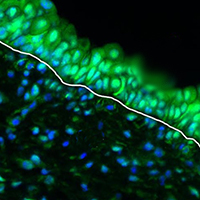Immunohistochemistry as a paramount tool in research of normal urothelium, bladder cancer and bladder pain syndrome

Accepted: 19 March 2021
HTML: 9
All claims expressed in this article are solely those of the authors and do not necessarily represent those of their affiliated organizations, or those of the publisher, the editors and the reviewers. Any product that may be evaluated in this article or claim that may be made by its manufacturer is not guaranteed or endorsed by the publisher.
Authors
The urothelium, an epithelium of the urinary bladder, primarily functions as blood-urine permeability barrier. The urothelium has a very slow turn-over under normal conditions but is capable of extremely fast response to injury. During regeneration urothelium either restores normal function or undergoes altered differentiation pathways, the latter being the cause of several bladder diseases. In this review, we describe the structure of the apical plasma membrane that enables barrier function, the role of urothelium specific proteins uroplakins and the machinery for polarized membrane transports in terminally differentiated superficial umbrella cells. We address key markers, such as keratins, cancer stem cell markers, retinoic acid signalling pathway proteins and transient receptor potential channels and purinergic receptors that drive normal and altered differentiation in bladder cancer and bladder pain syndrome. Finally, we discuss uncertainties regarding research, diagnosis and treatment of bladder pain syndrome. Throughout the review, we emphasise the contribution of immunohistochemistry in advancing our understanding of processes in normal and diseased bladder as well as the most promising possibilities for improved bladder cancer and bladder pain syndrome management.
Supporting Agencies
Slovenian Research Agency ARRSHow to Cite
PAGEPress has chosen to apply the Creative Commons Attribution NonCommercial 4.0 International License (CC BY-NC 4.0) to all manuscripts to be published.
Similar Articles
- V. Insolia, V.M. Piccolini, Brain morphological defects in prolidase deficient mice: first report , European Journal of Histochemistry: Vol. 58 No. 3 (2014)
- K. Fujikawa, T. Yokohama-Tamaki, T. Morita, O. Baba, C. Qin, S. Shibata, An in situ hybridization study of perlecan, DMP1, and MEPE in developing condylar cartilage of the fetal mouse mandible and limb bud cartilage , European Journal of Histochemistry: Vol. 59 No. 3 (2015)
- R Iwasaki, S Matsubara, T Takizawa, T Takayama, Human amniotic epithelial cells are morphologically homogeneous: enzymehistochemical, tracer, and freeze-substitution fixation study , European Journal of Histochemistry: Vol. 47 No. 3 (2003)
- A Germanà , MB Levanti, DF Monjil, E Ciriaco, Immunohistochemical detection of tyrosine kinase B (TrkB) in the enteric nervous system of the small intestine in pigeon (Columba livia) , European Journal of Histochemistry: Vol. 48 No. 4 (2004)
- Editor in Chief, In memoriam of Prof. GianCarlo Panzica , European Journal of Histochemistry: Vol. 66 No. 3 (2022)
- N Sjakste, T Sjakste, Possible involvement of DNA strand breaks in regulation of cell differentiation , European Journal of Histochemistry: Vol. 51 No. 2 (2007)
- M. Malatesta, G. Meola, Structural and functional alterations of the cell nucleus in skeletal muscle wasting: the evidence in situ , European Journal of Histochemistry: Vol. 54 No. 4 (2010)
- Carlo Alberto Redi, Stem Cells & Regenerative Medicine - From molecular embryology to tissue engineering , European Journal of Histochemistry: Vol. 55 No. 3 (2011)
- I.M.S. Paulsen, H. Dimke, S. Frische, A single simple procedure for dewaxing, hydration and heat-induced epitope retrieval (HIER) for immunohistochemistry in formalin fixed paraffin-embedded tissue , European Journal of Histochemistry: Vol. 59 No. 4 (2015)
- Shule Hou, Jiarui Chen, Jun Yang, Autophagy precedes apoptosis during degeneration of the Kölliker’s organ in the development of rat cochlea , European Journal of Histochemistry: Vol. 63 No. 2 (2019)
<< < 60 61 62 63 64 65 66 67 68 69 > >>
You may also start an advanced similarity search for this article.

 https://doi.org/10.4081/ejh.2021.3242
https://doi.org/10.4081/ejh.2021.3242










